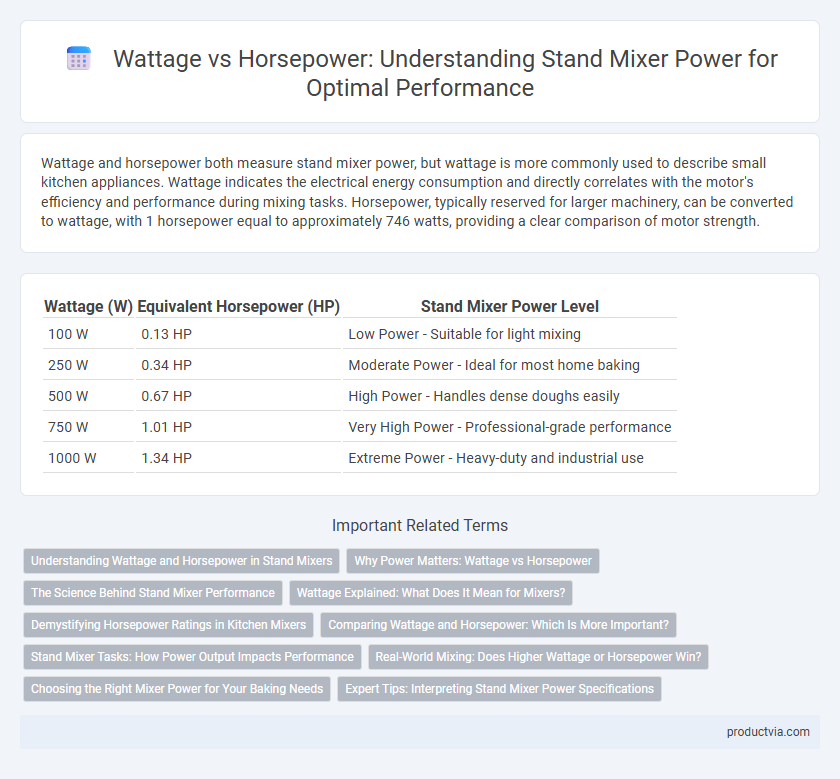Wattage and horsepower both measure stand mixer power, but wattage is more commonly used to describe small kitchen appliances. Wattage indicates the electrical energy consumption and directly correlates with the motor's efficiency and performance during mixing tasks. Horsepower, typically reserved for larger machinery, can be converted to wattage, with 1 horsepower equal to approximately 746 watts, providing a clear comparison of motor strength.
Table of Comparison
| Wattage (W) | Equivalent Horsepower (HP) | Stand Mixer Power Level |
|---|---|---|
| 100 W | 0.13 HP | Low Power - Suitable for light mixing |
| 250 W | 0.34 HP | Moderate Power - Ideal for most home baking |
| 500 W | 0.67 HP | High Power - Handles dense doughs easily |
| 750 W | 1.01 HP | Very High Power - Professional-grade performance |
| 1000 W | 1.34 HP | Extreme Power - Heavy-duty and industrial use |
Understanding Wattage and Horsepower in Stand Mixers
Wattage measures the electrical power consumption of stand mixers, while horsepower (HP) indicates the motor's mechanical power output, with 1 HP equaling 746 watts. Most home stand mixers range between 250 to 1000 watts, corresponding roughly to 0.3 to 1.3 HP, providing sufficient torque for mixing dough and batter. Understanding wattage and horsepower helps consumers evaluate motor strength and efficiency, ensuring the mixer meets baking and cooking demands without overheating or stalling.
Why Power Matters: Wattage vs Horsepower
Wattage measures the electrical power consumption of a stand mixer, providing a clear indicator of energy usage and motor strength, while horsepower quantifies the motor's mechanical output, often used to express peak power capabilities. Higher wattage generally means the mixer can handle tougher doughs and longer mixing times without overheating, directly impacting performance and durability. Understanding the balance between wattage and horsepower helps consumers select a stand mixer that delivers efficient, reliable power suitable for both everyday cooking and heavy-duty baking tasks.
The Science Behind Stand Mixer Performance
Stand mixer performance is primarily determined by its wattage and horsepower, which measure power in different units but both indicate motor strength. Wattage reflects the electrical energy consumption, typically ranging from 250 to 1000 watts in home stand mixers, directly influencing torque and speed consistency during heavy mixing tasks. Horsepower, often used interchangeably with wattage by dividing wattage by 746, provides a benchmark for motor capacity, where higher horsepower ensures more efficient handling of dense doughs and lengthy mixing without motor strain.
Wattage Explained: What Does It Mean for Mixers?
Wattage in stand mixers indicates the electrical power consumption and directly correlates to the mixer's motor strength and efficiency. Higher wattage typically means the mixer can handle denser doughs and prolonged use without overheating, ensuring consistent performance. Unlike horsepower, which measures mechanical output, wattage provides a clearer understanding of the motor's energy use and potential mixing power.
Demystifying Horsepower Ratings in Kitchen Mixers
Stand mixer power is often measured in watts rather than horsepower, which can cause confusion when comparing models. Horsepower ratings in kitchen mixers are typically a marketing metric and do not directly translate to motor performance like wattage does; for example, a 300-watt stand mixer does not literally deliver 0.4 horsepower despite what the label suggests. Understanding that wattage reflects actual electrical power consumption helps consumers make better-informed decisions about motor strength and durability in stand mixers.
Comparing Wattage and Horsepower: Which Is More Important?
Stand mixer power is often measured in both wattage and horsepower, with wattage indicating electrical power consumption and horsepower representing mechanical output strength. Most home stand mixers range from 250 to 1000 watts, equivalent to approximately 0.33 to 1.34 horsepower, highlighting that higher wattage generally means greater mixing capacity and durability. While horsepower can convey motor power, wattage is a more practical and standardized metric for evaluating a stand mixer's overall performance and energy efficiency.
Stand Mixer Tasks: How Power Output Impacts Performance
Stand mixer wattage directly influences motor strength, affecting the appliance's ability to handle various mixing tasks such as kneading dough or whipping cream efficiently. Higher wattage stand mixers deliver more consistent torque, ensuring better performance with heavy or dense ingredients. Comparing horsepower to wattage, wattage offers a clearer measurement of electrical power, critical for predicting a stand mixer's capability in performing demanding kitchen tasks.
Real-World Mixing: Does Higher Wattage or Horsepower Win?
Higher wattage in stand mixers often translates to more consistent torque and better endurance during heavy dough mixing, making it a crucial factor for real-world kitchen performance. Horsepower, while a traditional measure of motor power, can be less indicative of actual mixing capabilities due to variations in motor efficiency and design. For practical use, wattage provides a more reliable indication of a mixer's ability to handle dense ingredients and extended mixing tasks without overheating or stalling.
Choosing the Right Mixer Power for Your Baking Needs
Choosing the right stand mixer power involves understanding wattage and horsepower, two key indicators of motor strength and efficiency. Wattage measures the electrical power consumption, with typical mixers ranging from 250 to 1000 watts, supporting tasks from light whisking to heavy dough kneading, while horsepower, often between 0.25 to 1.5 HP, reflects the motor's mechanical output and durability. Selecting a mixer with sufficient wattage and horsepower ensures consistent performance for your baking needs, preventing motor strain during intensive mixing and extending your appliance's lifespan.
Expert Tips: Interpreting Stand Mixer Power Specifications
Stand mixer power is commonly specified in watts or horsepower, with watts offering a more precise measurement of electrical power consumption. Experts recommend focusing on wattage as it directly correlates to the motor's capacity to handle dense doughs and extended mixing tasks, with typical high-performance mixers ranging from 300 to 1000 watts. Horsepower ratings can be misleading since 1 horsepower equals 746 watts, but manufacturers often provide peak rather than continuous power, so wattage is a more reliable metric for assessing mixer performance.
Wattage vs Horsepower for stand mixer power Infographic

 productvia.com
productvia.com